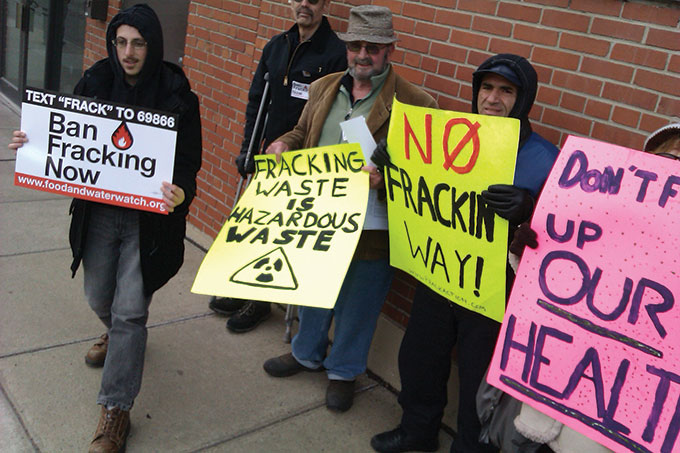It's Not Fracking Over Yet
by Geoff Kelly

The public comment period on the state’s proposed scheme for permitting fracking for natural gas in the Marcellus Shale expired on Wednesday. Still, the debate—over whether the practice is safe, whether it is the economic boon the oil and gas industry claims it to be, whether natural gas is in fact a reasonable “bridge” energy source—is hardly over.
Consider just these late additions to the conversation:
• This week, the New York chapter of Common Cause, a national lobbying organization, released a report called “Deep Drilling, Deep Pockets,” which analyzes campaign contributions by fracking advocates to New York State political parties, PACs, and elected officials. The authors found that between January 2007 and October 2011, drilling advocates made 2,349 donations to politicians and parties, totalling $1,340,246.58.
The biggest donor over that period was National Grid ($275,721.60), which has a significant stake in natural gas delivery infrastructure, namely the Millennium Pipeline, which runs from the Southern Tier’s Marcellus Shale to Rockland County, just north of New York City. Second place goes to Con Edison ($214,232.23), which is likewise invested in transmission infrastructure, and hopes that fracked natural gas will supply its extensive downstate customer base with cheap fuel and power. Third is National Fuel ($193,258), which derives almost half its income from piping and storing natural gas—activities to which fracking will be a boon. National Fuel also invests in shale gas exploration and drilling.
These are cheap investments, really, considering the vast amount of money energy companies hope to make by exploiting the state’s Marcellus Shale.
Governor Andrew Cuomo’s campaign was the biggest individual beneficiary of the industry’s largesse, taking in $153,816.06, more than half of which came from Competitive Power Ventures, which is backed by the private equity investing firm Warburg Pincus.
Candidates for State Senate received $460,631.10 in donations from the oil and gas industry. Life was especially good for Republicans, who control the Senate; they got two thirds of that money. The leading local recipients among senators were two Republicans: Niagara County’s George Maziarz, chair of the Senate’s Energy Committee ($38,532), and Amherst’s Michael Ranzenhofer, chair of the Senate’s Corporations and Authorities Committee ($21,175).
• On January 10, one day before the close of the public comment period, the Buffalo Niagara Riverkeeper released a statement taking issue with the complete lack of facilities statewide which are equipped to process the immense volume of wastewater generated by horizontal fracking operations; with the industry’s continued failure to disclose the constituent chemicals in the fluid pumped into wells to fracture the shale; and with the immense volume of water that the practice requires—water which will be drawn from local sources and which, once corrupted, can never be returned to the local water system.
The organization also expressed support for an industry fee structure that would allow the state’s Department of Environmental Conservation to hire sufficient staff to monitor fracking activity in the state’s shale beds, and the creation of an industry-supported remediation fund.
It is the first time Buffalo Niagara Riverkeeper has taken any public position in the debate.
• In an interview this week on the radio show The Capitol Pressroom, anti-fracking activist Doug Wood noted a curious fact: One section of the RDSGEIS dealing with air pollution caused by fracking operations (section 6.5.1.1) refers to another section (section 6.5.1.9) that will discuss diesel emissions. But the latter section fails to appear in the document. Even if regarded as a careless error by DEC, the omission may have significance as a matter of law: The EIS process is regarded as a partnership between DEC and citizens of the state, whom the agency must fully inform on the issue at hand. The omission of a section of the RDSGEIS, it could (and probably will) be argued, represents a failure to inform citizens fully, and compromises the validity of the EIS process.
Likewise, the DEC has proposed that gas drillers be required to make a full disclosure of the chemicals they’ll use to frack a well when they seek a permit for that well. But not all of those chemicals are identified in the RDSGEIS itself. So how can the public offer informed comments about the chemicals used in fracking and the potential dangers they pose?
Indeed, a Congressional report on chemicals used in fracking, based on industry testimony and released last April, suggests that it may not be possible to tell the public what’s being pumped into the ground:
Although some companies did provide information about these proprietary fluids, in most cases the companies stated that they did not have access to proprietary information about products they purchased off the shelf” from chemical suppliers. In these cases, the companies are injecting fluids containing chemicals that they themselves cannot identify.
About the same time that Congressional report was released, Doug Wood filed a Freedom of Information request for correspondence between the DEC the New York State Department of Health for all correspondence between those two agencies regarding potential human health consequences of fracking. He and his organization, Grassroots, have been stonewalled by DOH and DEC for more than eight months and counting.
blog comments powered by Disqus|
Issue Navigation> Issue Index > v11n2 (Week of Thursday, January 12) > Week in Review > It's Not Fracking Over Yet This Week's Issue • Artvoice Daily • Artvoice TV • Events Calendar • Classifieds |









 Current Issue
Current Issue